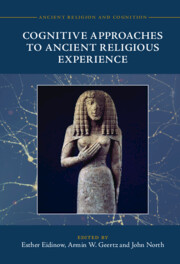Book contents
- Cognitive Approaches to Ancient Religious Experience
- Ancient Religion and Cognition
- Cognitive Approaches to Ancient Religious Experience
- Copyright page
- Contents
- Figures and Tables
- Contributors
- Abbreviations
- Funder Acknowledgement
- Introduction
- Part I Ritual
- Part II Representation
- Part III Gender
- Chapter 6 The Bacchants Are Silent
- Chapter 7 Who Is the Damiatrix?
- Part IV Materiality
- Part V Texts
- Index
- References
Chapter 6 - The Bacchants Are Silent
Using Cognitive Science to Explore the Experience of the Oreibasia
from Part III - Gender
Published online by Cambridge University Press: 28 July 2022
- Cognitive Approaches to Ancient Religious Experience
- Ancient Religion and Cognition
- Cognitive Approaches to Ancient Religious Experience
- Copyright page
- Contents
- Figures and Tables
- Contributors
- Abbreviations
- Funder Acknowledgement
- Introduction
- Part I Ritual
- Part II Representation
- Part III Gender
- Chapter 6 The Bacchants Are Silent
- Chapter 7 Who Is the Damiatrix?
- Part IV Materiality
- Part V Texts
- Index
- References
Summary
Tantalizing similarities between Euripides’ Bacchae and the historical ritual of the oreibasia— – a mountainside dance performed for Dionysus – have fascinated and polarized scholars for over a century. The wild women of myth are depicted as ecstatic devotees of the Dionysian cult, or as raging, murderous avatars of the god’s vengeance. But in the tightly regulated civic cult, ritual practitioners were respectable women who honoured Dionysus by imitating his mythological entourage.<break/>The question of whether ritual participants could have experienced ecstasy and epiphanic visions has stimulated a long-running debate encompassing hysteria, belief, and the interplay between cult and myth. Lacking first-hand accounts, historians have struggled with reconciling the ecstatic ‘madwomen’ of myth with the prestige of the civic cult performance, but the apparent gap between ritual performers and mythical exemplars may not be so wide. Inspired by Jan Bremmer’s 1984 paper on the physiological effects of the oreibasia, I revisit the ancient evidence with a cognitive interpretative framework, looking at ritual experience in the embodied mind. Incorporating theories of agency detection and predictive processing, I explore how an interdisciplinary approach can integrate artistic and historical narratives, and better understand the lived experience and religious identity of historical maenads.
- Type
- Chapter
- Information
- Cognitive Approaches to Ancient Religious Experience , pp. 145 - 166Publisher: Cambridge University PressPrint publication year: 2022

